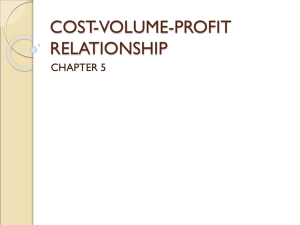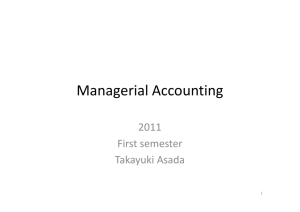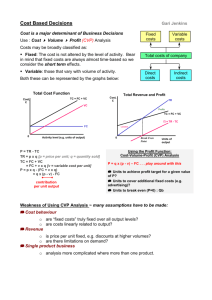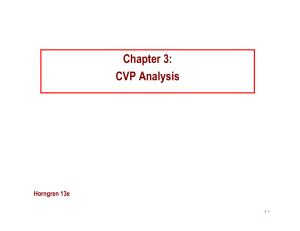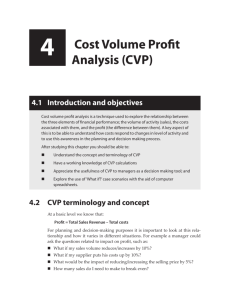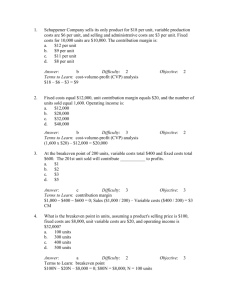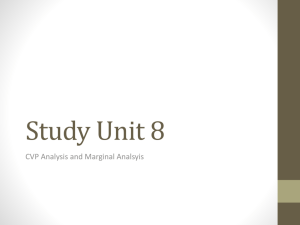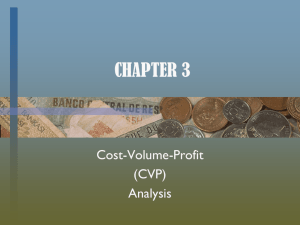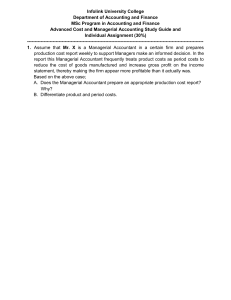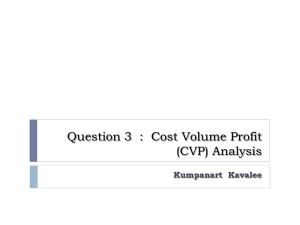bYTEBoss 03
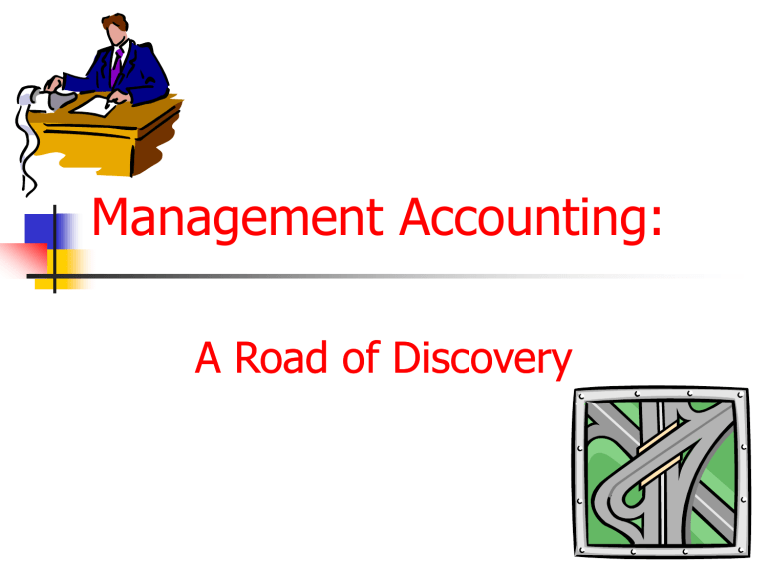
Management Accounting:
Management Accounting
:
A Road of Discovery
James T. Mackey
Michael F. Thomas
Presentations by:
Roderick S. Barclay
Texas A&M University - Commerce
James T. Mackey
California State University - Sacramento
© 2000 South-Western College Publishing
Chapter 3
How much profit can we make?
Proforma income statements and CVP analysis
Key Learning Objectives
• Explain the four cost behavior patterns.
• Develop a profit equation and use it in cost-volume-profit analysis.
• [Appendix A] Describe three statistical techniques to break down a mixed cost into its variable and fixed components.
7
. [Appendix C] Apply CVP analysis to multiple product lines.
• Create a contribution margin- based income statement and compare it to a functional format.
• Perform “shat-if” analysis with the profit equation.
• [Appendix B] Modify the profit equation to include income taxes.
‘Management by the Numbers’
Putting the company on automatic pilot and using only accounting measures to guide business activities and operational decisions.
Using financial targets to plan activities.
A pro-forma income statement provides a projected net income figure.
A pro-forma manufacturing statement provides the cost of goods manufactured figure needed to provide the projected net income.
In order to attain the cost of goods manufacture projection, the company must design activities, and conduct operations in a manner to reach the required production at the projected cost.
The Economic Cost Model versus the
Accounting Cost Model
The Accounting Cost Model
$
Units of Output or Volume
Economic costs per unit are high below and above the designed capacity, but stabilize within a specified range of activity.
Management Philosophy
Within the relevant range we can classify costs as either variable or fixed with respect to volume and make ‘good decisions’.
Understanding Volume Based Cost
Behavior Patterns
How do costs change when the volume of goods and services provided changes?
‘Cost Object’ — The activity, product or function for which costs are gathered.
When output is the cost object, costs are defined by how they change as volume changes.
Variable Costs
‘Variable costs’ change proportionately with changes in the volume of the cost objects.
$
Output volume
Variable costs are resources consumed whenever a unit of product is produced; e.e. direct labor, direct materials and some overhead costs.
Fixed Costs
‘Fixed costs’ do not change with changes in volume of the cost objects.
$
Output volume
Fixed costs are resources that may change for other reasons, but do not necessarily change when an additional unit is produced; e.g. taxes, rent, corporate level salaries.
Cost Properties
As variable costs per unit increase.
‘Unit costs’ do not change.
‘Total costs’ increase in proportion to volume.
As fixed costs increase.
‘Unit costs’ decrease as volume increases.
‘Total costs’ do not change.
Cost Estimates for Multree’s Standard
Home Line
Fixed Costs Overhead Costs
Indirect materials
Indirect labor
Powr
Architectural
Supervision
Total overhead costs
Other costs
Direct materials
Direct labor
Sales commissions
Advertising
Total other costs
Total production costs
Variable Costs
$ 1,000 per house
500 per house
500 per house
$ 2,000 per house
$15,500 per house
10,000 per house
2,500 per house
$28,000
$30,000 per house
$ 10,000 per year
100,000 per year
$110,000 per year
$ 50,000 per year
$160,000 per year
Graphic View of Cost Behavior Patterns
$700
$600
$500
$400
$300
$200
$100
$ 0
0 10 20 30 40 50
Graphic View of Cost Behavior Patterns
$700
$600
$500
$400
$300
$200
$100
$ 0
Small steps
Large steps
0 10 20 30 40 50
Additional Constraints of Non-Linear
Changes
Step costs can be classified as fixed or variable depending on the width of the steps.
Long steps are treated as fixed within the relevant range because they usually do not change until after the ‘relevant range’ we are considering.
Short steps are usually classified as variable costs because they change within the ‘relevant range’ we are considering.
Contribution Margin Based income
Statements
Comparison with functional income statements.
Convert functional costs into variable and fixed classifications.
The ‘Contribution margin’ is the money available to cover fixed costs and provide a profit.
Multree Homes Proforma Income
Statement — Comparing Formats
Functional Format
Revenues
Less COGS
Direct materials and labor
Indirect materials and labor
Power
Architectural costs
Depreciation
Supervision
Heat and light
Gross Profit
Less Expenses
Sales commissions
Advertising and administration
Net income
Contribution Margin Based Format
Revenues
Less COGS
Direct materials and labor
Indirect materials and labor
Power
Sales Commissions
Gross Profit
Less Expenses
Advertising and administration
Architectural costs
Depreciation
Supervision
Heat and light
Net Income
The Need for Contribution Margin per Unit
(CMU)
Management wants to know the impact on profits of each unit in order to set prices, determine strategy and the volume of sales needed to achieve target profits.
Multree Homes Standard Homes Proforma
Income Statement
Per Unit
$50,000
%
100%
Total for 100 Units
$5,000,000 Revenues
Less Variable Costs
Direct materials
Direct labor
Indirect materials
Indirect labor
Power
Sales commissions
Total
Contribution Margin
Less Direct Fixed Costs
Advertising
Architectural costs
Supervision
Total
Product line margin
15,500
10,000
1,000
500
500
2,500
$ 30,000
$ 20,000
31%
20%
2%
1%
1%
5%
60%
40%
1,550,000
1,000,000
100,000
50,000
50,000
250,000
$3,000,000
$2,000,000
50,000
10,000
100,000
$ 160,000
$1,840,000
The Concept of Relevant Range
Fixed costs and variable costs are incorrect or misleading outside the
‘relevant range’.
If any of these costs are used outside the ‘relevant range’, they may lead to bad decisions.
Outside of the ‘relevant range’ the linear quality of fixed and variable costs usually does not exist.
Cost-Volume-Profit (CVP) Analysis
Building the CVP Equation
The CVP equation is a contribution format income statement
Sales = variable costs + fixed costs + profit
For Exhibit 3-4:
$6,000,000 = $3,600,000 + $1,400,000 +
$1,000,000
For the Standard Product Line (Exhibit 3-6)
$5,000,000 = $3,000,000 + $160,000 +
$1,840,000
Using CVP to Manage
Use the proforma CVP statement and formula for ‘what if’ questions, such as
If we know fixed our costs, how many products must we sell to break even?
If we know how many units we can sell, what cost structure must we maintain to break even?
If we know our fixed costs, what must our variable costs be to break even?
Given our capacity, what price must we sell our products for to break even?
$
Cost Analysis Using the CVP Graph
Any point on the line = total revenue at this volume
Slope of line = selling price per unit
Units
Cost Analysis Using the CVP Graph
$6,000
$
$5,000
$4,000
Any point on this line = total revenue at this volume
$3,000
$2,000
$0
Slope of line = selling price per unit
0 200 400 600 800 1,000 1,200 Units
What is the Breakeven Volume or Sales?
In Accounting, the Breakeven point is where sales just cover all our costs. We have zero profits. The contribution margin from all sales greater than the
Breakeven point are profit.
The Economics version of Breakeven is defined differently.
How does the CVP Chart Change to
Reflect Cost Management
What if we reduce our fixed costs?
What if we increase our fixed costs?
What if we increase our variable costs?
What if we decrease our variable costs?
What Questions Can we Answer?
How many units do we need to sell to cover our standard product line costs?
(Fixed costs to recover) divided by the CMU.
$160,000 / $20,000 = 8 houses
How many units do we need to sell to recover our product line fixed costs and meet our target profit of $160,000?
The ‘Contribution Margin Ratio’
It is defined as the contribution to cover fixed costs and profit for the average sales dollar.
Using Multree’s standard line, it is
$20,000/$50,000 or 40% of every dollar of sales.
Use the contribution margin ratio to calculate the sales required to breakeven or cover the product line fixed costs.
Calculate the sales required to cover the product line fixed costs and target profits.

